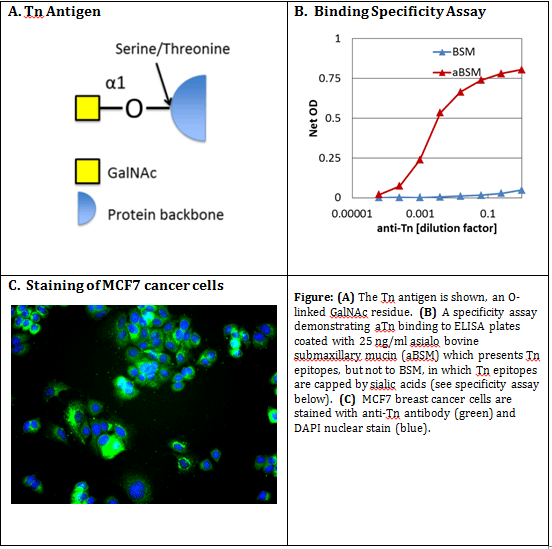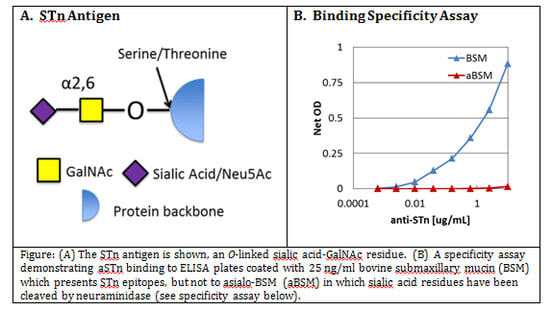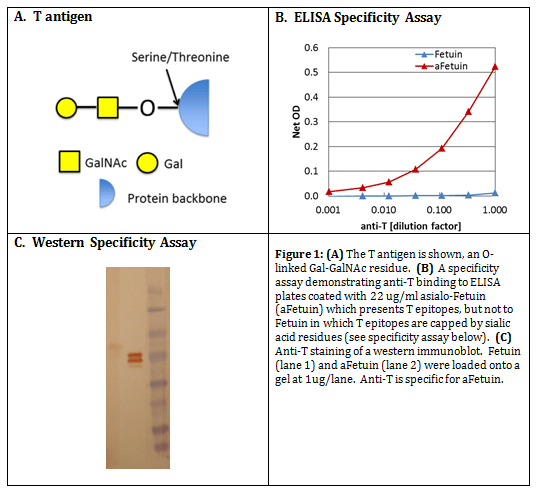Glycobiology Products
O-Linked Glycosylation Toolkit
SBH Sciences offers a portfolio of tools for studying O-linked glycosylation, including highly active glycosyltransferase enzymes for building glycan structures on peptides or proteins, as well as monoclonal antibodies specific to the glycan structures.
Recombinant Glycosyltransferase Enzymes
We currently offer 8 recombinant glycosyltransferase enzymes:
- GalNAc-T2
- GalNAc-T3
- GalNAc-T5
- GalNAc-T16
- B3GnT6/Core 3
- B4GalT1
- ST6GalNAc1
- ST3Gal1
To learn more about these important enzymes and O-glycosylation in general, please visit the Glycosyltransferase Enzymes page. To learn more about each enzyme in particular, please click on each enzymes name above.
Monoclonal Anti-carbohydrate Antibodies
We currently offer 3 monoclonal anti-carbohydrate antibodies, to carbohydrate antigens that are highly up-regulated in cancerous tissues:
To learn more about the Tn, STn, T and other carbohydrate-based, cancer-specific antigens, please visit the Carbohydrate Cancer Antigens page. To learn more about the specific antibodies, please click on each antibody name above.
SBH Sciences is looking for partners to investigate our glycosyltransferase enzymes and carbohydrate antibodies as diagnostic tools, therapeutics or for production of glycol-peptide/glycol-protein products. Moreover, our extensive bioassay and in vitro biomarker analysis capabilities are available to support development of your product.
We are open for suggestions and would be pleased to hear from you.
Our expertise is your competitive edge!
Anti-Tn Antibody

Description:
Dysregulation of cellular glycosylation is a common characteristic of many cancers (1). The Tn antigen (GalNAcα1-O-Ser/Thr), is up-regulated in a wide variety of cancers (2,3), and has been investigated as a diagnostic & prognostic marker, and as a therapeutic (4). It has also been explored as a component of anti-cancer vaccines (5). The specificity of aTn was shown by binding to asialo bovine submaxillary mucin (aBSM), which presents the Tn antigen, and not to BSM in which the Tn epitope is shielded by sialic acid residues (ref 3 and Figure 1 panel B). This antibody has previously been sold under the name HB-Tn (6,7).
- Hakomori, S. (1996) Cancer Res. 56, 5309.
- Springer, G.F. (1984) Science 224, 1198.
- Kjeldsen, T. et al. (1988) Cancer Res. 48, 2214.
- Desai, P. (2000) Transfusion Med. Rev. 14, 312-25.
- Ingale, S. et al. (2007) Nat. Chem. Biol. 10, 663.
- Marcos, N.T. et al. (2004) Cancer Res. 64, 7050.
- Julian, S. et al. (2001) Glycocon. J. 18, 883.
Preparation: Monoclonal antibodies were produced from mouse hybridoma 5F4 clone.
Purification: Three step liquid chromatography, proprietary.
Catalog #: SBH-Tn
Formulation: Sterile filtered solution of PBS at 0.5mg/ml.
Stability: Stable for 4 weeks at 4C. Stable for 6 months at -80C. Avoid repeated freeze-thaw cycles.
Purity: Greater than 90% by SDS-PAGE.
Reconstitution: N/A
Specificity Assay: To create asialo bovine submaxillary mucin (aBSM), 30mg of BSM (Sigma M3895) was treated with 5U of Neuraminidase (Sigma N2876) for 2 hrs at 37⁰C. Double dilution ELISAs were carried out by coating 96 well plates with a 1:2 serial dilution of 10ng/ml BSM or aBSM, blocking and incubating with a 1:4 serial dilution of anti-Tn (SBH-Tn). After washing, plates were incubated with a goat-anti-mouse (IgG+IgM)-HRP conjugate (Thermo 31446) at 1:1000 dilution. After washing, plates were developed with 2x ABTS (Southern Biotech 0202-01). Net OD was measured at 405 – 650 nm. SBH-Tn MAb diluted 4,000 fold could detect aBSM coated at 25 ng/ml, with 30 fold less signal for BSM (see Figure 1 panel (B) above).
Usage: For research only. Not for use in diagnostic or therapeutic procedures.
Country of Origin: USA
To learn more about the Tn, STn, T and other carbohydrate-based, cancer-specific antigens, please visit the Carbohydrate Cancer Antigens page.
Anti-STn Antibody

Description:
Dysregulation of cellular glycosylation is a common characteristic of many cancers (1). The STn antigen (Neu5Acα2-6GalNAcα1-O-Ser/Thr), also known as the sialyl-Tn antigen, is up-regulated in a wide variety of cancers (2). It is formed from the Tn antigen (GalNAcα1-O-Ser/Thr) through the action of the ST6GalNAc family of enzymes (3,4). STn-Keyhole Limpet Hemocyanin conjugate has been tested as an anti-cancer vaccine (5). The specificity of the anti-STn monoclonal antibody was shown by binding to bovine submaxillary mucin (BSM), which presents the STn antigen, and not to asialo-BSM (ref 2 and Figure 1 panel B). This antibody was previously marketed under HB-STn (3,4).
- Hakomori, S. (1996) Cancer Res. 56, 5309.
- Kjeldsen, T. et al. (1988) Cancer Res. 48, 2214.
- Marcos, N.T. et al. (2004) Cancer Res. 64, 7050.
- Julian, S. et al. (2001) Glycocon. J. 18, 883.
- Miles, D. et al. (2006) J. Biol. Chem. 281, 3586.
Preparation: Monoclonal antibodies were produced from the mouse hybridoma 3F1 clone (HB-STn).
Purification: This IgG1 was purified by Protein G affinity chromatography.
Catalog #: SBH-ASTn
Formulation: Sterile filtered solution PBS, at a stock concentration of 640 ug/mL.
Stability: Stable for 4 weeks at 4C. Stable for 6 months at -80C. Avoid repeated freeze-thaw cycles.
Reconstitution: N/A
Specificity Assay: To create asialo bovine submaxillary mucin (aBSM), 30mg of BSM (Sigma M3895) was treated treated with 5U of Neuraminidase (Sigma N2876) for 2 hrs at 37⁰C. Double dilution ELISAs were carried out by coating 96 well plates with a 1:2 serial dilution of 10ng/ml BSM or aBSM, blocking and incubating with a 1:4 serial dilution of 10ug/ml anti-STn (SBH-STn). After washing, plates were incubated with a goat-anti-mouse (IgG+IgM)-HRP conjugate (Thermo 31446) at 1:1000 dilution. After washing, plates were developed with 2x ABTS (Southern Biotech 0202-01). Net OD was measured at 405 – 650 nm. As low as 2ng/ml SBH-STn MAb could detect BSM coated at 25 ng/ml, with no detectable binding to aBSM (see Figure 1 panel (B) above).
Usage: For research only. Not for use in diagnostic or therapeutic procedures.
Country of Origin: USA
To learn more about the Tn, STn, T and other carbohydrate-based, cancer-specific antigens, please visit the Carbohydrate Cancer Antigens page.
Anti-T Antibody

Description:
Dysregulation of cellular glycosylation is a common characteristic of many cancers (1). The T antigen (Galβ1,3-GalNAcα1-O-Ser/Thr ) is up-regulated in a wide variety of cancers (2, 3), and has been investigated as a diagnostic & prognostic marker, and as a therapeutic and vaccine (4, 5). The specificity of the anti-T monoclonal antibody was shown by binding to asialo-fetuin, which presents the T antigen, and not to fetuin, in which the T antigen is capped by sialic acid residues (3). This antibody was previously marketed under HB-T (6).
- Hakomori, S. (1996) Cancer Res. 56, 5309.
- Springer, G.F. (1984) Science 224, 1198.
- Kjeldsen, T. et al. (1988) Cancer Res. 48, 2214.
- Desai, P. (2000) Transfusion Med. Rev. 14, 312-25.
- Springer, G.F. (1997) J. Mol. Med. 75, 594.
- Marcos, N.T. et al. (2004) Cancer Res. 64, 7050.
Preparation: Monoclonal antibodies were produced from the mouse hybridoma 3C9 clone (HB-T).
Purification: Three step liquid chromatography, proprietary.
Catalog #: SBH-T
Formulation: Sterile filtered solution PBS.
Stability: Stable for 4 weeks at 4C. Stable for 6 months at -80C. Avoid repeated freeze-thaw cycles.
Reconstitution: N/A
Specificity Assay: To create asialo Fetuin (aFet), 5mg of Fetuin (Sigma F3004) was treated with 2U of Neuraminidase (Sigma N2876) for 2 hrs at 37⁰C. Double dilution ELISAs were carried out by coating 96 well plates with a 1:3 serial dilution of 67ug/ml Fet or aFet, blocking and incubating with a 1:3 serial dilution of anti-T (SBH-T). After washing, plates were incubated with a goat-anti-mouse (IgG+IgM)-HRP conjugate (Thermo 31446) at 1:1000 dilution. Plates were developed with 2x ABTS (Southern Biotech 0202-01). Net OD was measured at 405 – 650 nm. SBH-T MAb diluted 10 fold could detect aFet coated at 22 ug/ml, with 200 fold less signal for Fet (see Figure 1 panel (B) above).
Usage: For research only. Not for use in diagnostic or therapeutic procedures.
Country of Origin: USA
To learn more about the Tn, STn, T and other carbohydrate-based, cancer-specific antigens, please visit the Carbohydrate Cancer Antigens page.
